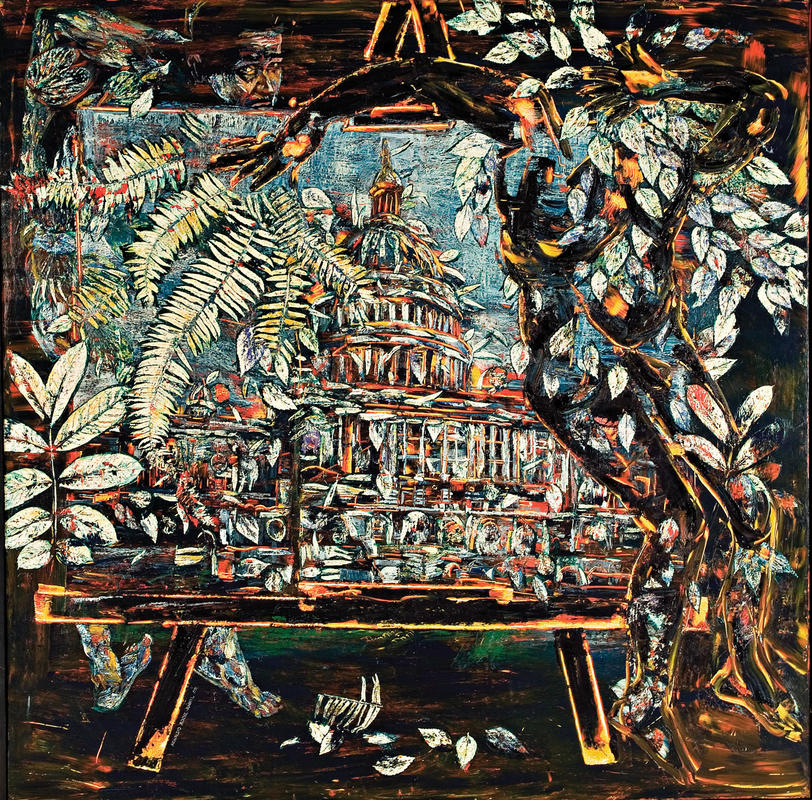More about Total Eclipse of the Sun

Contributor
Under a Total Eclipse of the Sun by Roche Rabell is a work that speaks to me on a soul level.
I love it, and I love the way that it tells a story of Puerto Rico, of the Caribbean, its indigenous peoples, its colonists and African peoples, and its challenging relationship to the United States. Maybe my love for the painting is eclipsed by my own memories: as the unenrolled child of a former councilman for a federally recognized tribe, and the adopted son of a Cuban-Irish woman, I also have a relationship to colonialism, the Caribbean, and indigeneity. Nevertheless, no matter one's background, it seems that in order to understand the U.S. we must to listen to Puerto Ricans, to indigenous peoples, Africans and all those who the "Founding Fathers" did not particularly have in mind in 1789. In the same way, I can't really understand men by examining myself or by listening to other men; I have to listen to the observations women make about us, as hard as that is on the ego, to get the full picture, because, not being men, women see things about us that we overlook. Likewise, Bajo un eclipse total de sol, translated into English as Under a Total Eclipse of the Sun, gives a particularly spiritual, intimate, and insightful view of the power center of Washington, D.C. from a Caribbean perspective, which has no vested interest in overlooking its flaws.
Like Russian nesting dolls, Under a Total Eclipse of the Sun features an artwork within an artwork, showing a painting of the U.S. Capitol building on an easel. Two human forms appear on either side of the easel, and they might be representations of the same character at different moments. The theme of leaves, done by Roche Rabell as impressions from actual leaves, as a form of camouflage, overwhelms the painting. In order to bring the human body directly into his work, Roche Rabell made human sushi rolls out of his canvases, wrapping his subjects in them and tracing their forms directly.
The Puerto Rican, as a U.S. citizen, belongs to the "Republic for which It Stands," but does not receive the same entitlements in terms of social and economic access as those of us who live in the fifty states. The Caribbean story emerges from the relations between indigenous people, the descendants of Africans and Asians, and European colonists. Caribbeans develop specific languages based on English, Spanish, and African languages, and those languages come to define the sensibility of the Americas in general, especially in terms of hip hop, reggaeton and dancehall cultures. The "power and magic" of art, to paraphrase Maryse Condé, "knows no borders, it is the realm of hard to reach dreams, obsessions, and desires, which unites readers through time and space."
If the "sun" is the power of the U.S., epitomized in the architecture of the Capitol building, the "eclipse" is, in part, the perspective of those who are Americans but not "Estadounidenses," aka U.S. citizens. Only when the U.S. listens to Americans who are not part of the U.S., can it truly live up to its lofty title, the United States of America.
Sources
- "ARNALDO ROCHE RABELL (1955–2018)." ArtForum, Nov. 18, 2018, https://www.artforum.com/news/arnaldo-roche-rabell-1955-2018-77709.
- Condé, Maryse. "Giving Voice to Guadeloupe." NYR Daily, Feb. 6, 2019, https://www.nybooks.com/daily/2019/02/06/giving-voice-to-guadeloupe/.
- Dimitriadis, Greg. Reading and Teaching the Postcolonial: From Baldwin to Basquiat and Beyond. New York: Teachers College Press, 2001.
- Martinez, Javier. "Arnaldo Roche Procesos de Pintura." Autogiro, Nov. 17, 2018, https://autogiro.cronicaurbana.com/es/arnaldo-roche-procesos-de-pintura/.











